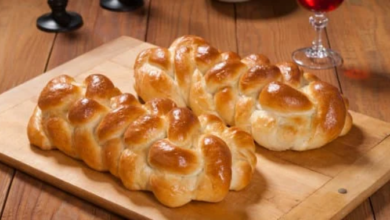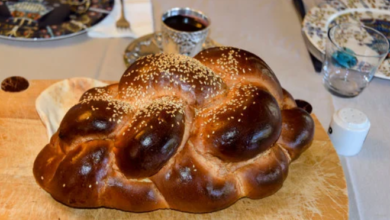Challah Vs. Babka: How Are They Different?

What To Know
- Whether you prefer the classic elegance of challah or the indulgent richness of babka, there is a braided bread to satisfy every palate.
- The braiding in challah symbolizes fertility and prosperity, while the braiding in babka adds to its visual appeal and allows for different fillings to be incorporated.
- Challah is more versatile as it can be eaten with both savory and sweet dishes, while babka is typically enjoyed as a dessert or sweet treat.
In the realm of Jewish cuisine, challah and babka reign supreme. These two braided breads tantalize taste buds with their distinct flavors and textures, sparking a friendly rivalry among bread enthusiasts. This blog post will delve into the fascinating world of challah vs babka, exploring their unique characteristics, culinary significance, and the passionate debates they inspire.
Appearance: A Visual Distinction
Challah, often referred to as the “Jewish bread,” is characterized by its golden-brown crust and intricate braiding. The braids typically follow a three-strand pattern, symbolizing fertility and prosperity. In contrast, babka boasts a more whimsical appearance with its swirled dough. Layers of chocolate, cinnamon, or other fillings are rolled into the dough, creating a vibrant and eye-catching treat.
Taste and Texture: A Sensory Delight
Challah’s flavor profile is mild and slightly sweet, with a soft and fluffy texture that melts in the mouth. Its versatility makes it an excellent accompaniment to a wide range of dishes, from savory soups to sweet jams. Babka, on the other hand, offers a richer and more decadent taste experience. The chocolate or cinnamon fillings provide a burst of sweetness, while the dough maintains a slightly chewy texture.
Culinary Significance: A Cultural Connection
Challah holds immense cultural significance in Jewish traditions. It is traditionally served on Shabbat (the Jewish Sabbath) and holidays, symbolizing the manna that sustained the Israelites during their journey through the desert. Babka, while not as deeply rooted in Jewish history, has become a beloved treat associated with Jewish communities. Its sweet and comforting flavors evoke a sense of nostalgia and celebration.
The Braiding Technique: A Matter of Skill
The braiding of challah and babka requires both precision and artistry. Challah is typically braided with three strands, while babka can feature a wider range of braiding patterns, including four or six strands. The skillful execution of these braids adds to the aesthetic appeal and unique character of each bread.
Fillings and Variations: A World of Possibilities
While challah is traditionally unfilled, babka offers endless possibilities for experimentation. Chocolate, cinnamon, nuts, and fruits are common fillings that transform the bread into a delightful dessert. Variations of babka include the popular chocolate babka, cinnamon babka, and the more unconventional matcha babka.
The Great Debate: A Matter of Preference
The challah vs babka debate is a heated one, with passionate advocates on both sides. Some prefer the simplicity and versatility of challah, while others adore the decadent sweetness and visual appeal of babka. Ultimately, the choice comes down to personal taste and the occasion.
Final Thoughts: A Symphony of Breads
Challah and babka are both exceptional breads that hold a special place in Jewish cuisine and beyond. Their distinct flavors, textures, and cultural significance make them beloved treats that continue to inspire culinary creativity. Whether you prefer the classic elegance of challah or the indulgent richness of babka, there is a braided bread to satisfy every palate.
Basics You Wanted To Know
1. Which bread is sweeter, challah or babka?
Babka is generally sweeter than challah due to the fillings used, such as chocolate or cinnamon.
2. Can challah be filled with ingredients?
While traditional challah is unfilled, variations exist that incorporate fillings such as raisins, nuts, or even cheese.
3. What is the significance of braiding in challah and babka?
The braiding in challah symbolizes fertility and prosperity, while the braiding in babka adds to its visual appeal and allows for different fillings to be incorporated.
4. Which bread is more versatile?
Challah is more versatile as it can be eaten with both savory and sweet dishes, while babka is typically enjoyed as a dessert or sweet treat.
5. How do I store challah and babka?
Both challah and babka can be stored at room temperature for up to 3 days. For longer storage, they can be frozen for up to 3 months.





